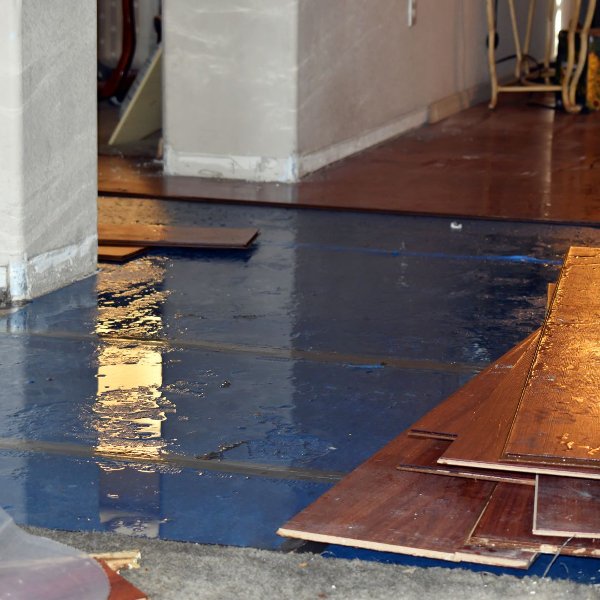Blog > How to Handle Water Damage on Your Flooring: A Step-by-Step Guide
How to Handle Water Damage on Your Flooring: A Step-by-Step Guide
Thursday, January 2, 2025

Water damage can happen in many ways—whether from a burst pipe, flooding, or even spills that go unnoticed. When water soaks into your flooring, it can cause extensive damage if not addressed quickly. Hardwood, carpet, laminate, and tile floors each have their own vulnerabilities when exposed to water, and the longer you wait to act, the more expensive and complicated the repairs become. Here's a quick guide to help you handle water damage on your flooring.
Act Fast – Time is Critical
When it comes to water damage, the faster you act, the better the outcome will likely be. Water can quickly seep into the flooring and subfloor, causing warping, mold growth, or other structural issues. As soon as you notice the damage:
- Shut off the water source if the damage is from a leak or flooding.
- Remove standing water using towels, a wet/dry vacuum, or a pump, depending on the extent of the flooding.
- Ventilate the space by opening windows or using fans and dehumidifiers to speed up the drying process.
Identify the Extent of the Damage
Once the water is cleared, it’s important to assess the damage to your flooring. Check for:
- Warping or buckling: This is common with hardwood and laminate floors when water seeps into the planks.
- Discoloration: Stains or discoloration may be a sign of deep water penetration, especially with carpets or wood floors.
- Mold or mildew: This can develop in areas where water has remained for a prolonged period.
If the damage appears to be extensive, it may be best to consult a professional to avoid further issues.
For Hardwood Floors
Water is particularly damaging to hardwood floors, as it can cause warping and swelling. If you act fast, you may be able to salvage the flooring.
- Wipe up water immediately: Use towels to blot up water from the surface. Avoid excessive scrubbing, as this can cause the wood to swell further.
- Dry with fans or a dehumidifier: Pointing fans at the affected area and using a dehumidifier can help remove moisture from the wood.
- Replace damaged planks: If the warping is severe, the affected planks may need to be replaced. In some cases, sanding and refinishing the wood may restore it to its original state.
In cases of extensive damage, you might need to consult a professional hardwood floor repair service.
For Laminate Flooring
Laminate flooring is more resistant to water than hardwood, but prolonged exposure can still cause swelling and warping.
- Quick cleanup: Laminate doesn’t absorb water as quickly as hardwood, but it’s still essential to clean up any water immediately.
- Dry it properly: Ensure that fans or a dehumidifier are used to dry the floor quickly, especially in the seams where water can seep in.
- Replace affected sections: If the laminate has swollen or warped, you may need to replace the individual planks.
Laminate is often more affordable to replace than hardwood, but be sure to match the new planks to the existing ones for a consistent look.
For Carpeted Floors
Carpet can absorb a lot of water, which increases the risk of mold and mildew growth. The good news is that many carpets can be salvaged if you catch the water damage early enough.
- Remove excess water: Use a wet/dry vacuum or towels to soak up as much water as possible.
- Dry thoroughly: Use fans, dehumidifiers, or even rent industrial drying equipment to dry the carpet quickly.
- Check for mold: After the carpet has dried, check for signs of mold. If any appears, the carpet may need professional cleaning or replacement.
- Consider replacing the padding: The padding beneath the carpet may retain water and develop mold. You may need to replace it entirely for proper restoration.
For Tile Floors
Tile floors are relatively water-resistant, but the grout and adhesive beneath the tiles are vulnerable to water damage. If you notice water damage on a tiled floor, follow these steps:
- Dry quickly: Remove water from the surface using towels or a mop, and use fans to ensure the area dries completely.
- Inspect the grout lines: Water can seep into the grout and cause it to crack or loosen over time. If this happens, you may need to re-grout the area.
- Check for damage beneath the tiles: In extreme cases, water can seep beneath the tiles and affect the subfloor. If you notice any shifting or popping tiles, it’s important to address the issue quickly.
Prevent Future Water Damage
Once you've handled the immediate aftermath of water damage, it’s essential to take steps to prevent future occurrences:
- Fix leaks promptly: Regularly check for leaks in pipes, faucets, and appliances.
- Install water barriers: Consider adding water barriers around the most vulnerable areas, such as the kitchen and bathroom.
- Use rugs or mats: In areas prone to spills, such as the entryway or kitchen, consider placing absorbent rugs or mats to catch water before it hits the floor.
Know When to Call a Professional
While small water issues can often be handled on your own, there are times when it’s best to call in the experts. If the water damage is extensive, affects large areas of your home, or has caused mold growth, it’s important to contact a water damage restoration company. They have the equipment and expertise to remove water, dry the area, and restore your floors and home.
Water damage to flooring is stressful, but with prompt action, you can minimize the damage and restore your floors to their original state. Whether it’s hardwood, laminate, carpet, or tile, knowing the right steps to take can save you time, money, and headaches in the long run. If the damage is severe and requires new flooring, Jason’s Carpet and Tile is here to help. Call us today 954-231-4487.
